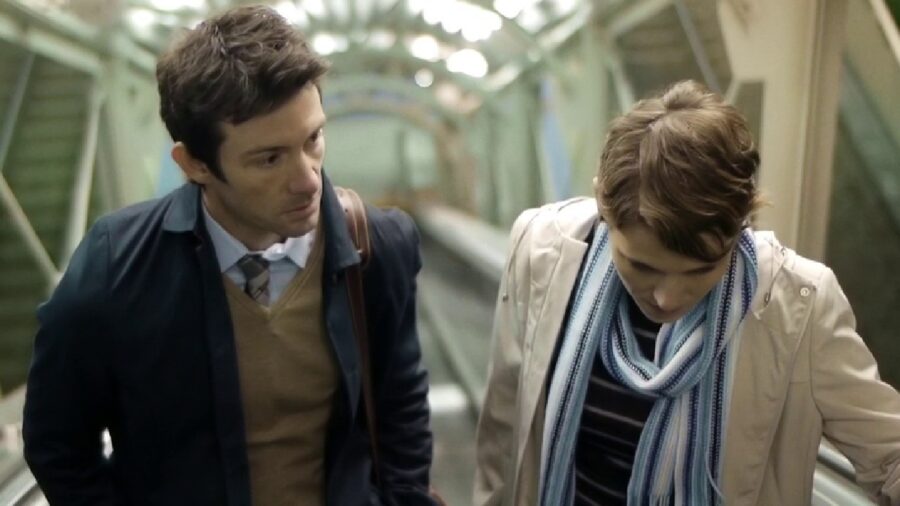Upstream Color Movie Review: Worth The Nine-Year Wait
Primer's Shane Carruth returns to the big screen.

We’ve been waiting almost a decade for Shane Carruth’s, Upstream Color, a follow-up to his 2004 time travel mindfuck, Primer. Filmed for like fifty bucks and some personal favors, and largely inside a storage locker, Primer is a layered, intricate portrait of a character going back in time over and over again in an attempt to right the wrongs of his past, only to make things worse with each subsequent trip.
His second sci-fi-themed feature, Upstream Color, is a different beast entirely. Romantic, metaphorical, and methodically paced, the story is much more linear, though equally disorienting and moving.
In Upstream Color, there is a very specific type of wriggly little grubs that, after feeding on just the right species of plant, cause a very peculiar phenomenon. A tea made from the worms leads to a synchronicity of movement between people. But when ingested whole, these buggers leave you wide open to any and all suggestions, and susceptible to all sorts of outlandish propositions, like emptying your bank account for a complete stranger.
After being injected—injected may be the wrong word, let’s say purposely infested—with these mind-control worms, Kris (Amy Seimetz) is piloted around, being bled dry by a nameless bandit (Thiago Martins).
Left broke, schizophrenic, and traumatized, she encounters Jeff (Carruth) on a commuter train. A disgraced former broker, recovering addict, and divorcee, he’s got a slew of his own personal demons to contend with.
At its heart, Upstream Color is a story of two broken, wounded people. They lie to themselves and each other just to make it through the harrowing mess that is their daily lives, trying to keep from unraveling completely. That’s really where your emotional investment arrives, in their attempts to come to terms with their pasts and their present and find a way to continue on into the future.

Initially, in Upstream Color, Kris and Jeff come across as a little too perfectly damaged and scuffed up in a way that you only encounter in the movies. Carruth, however, has a way of setting you in a disorienting proximity to his subjects.
Much of Upstream Color is framed so that the screen is taken up, top to bottom, with their faces. Everything around them pushes and pulls, in and out of focus, like a hazy, half-remembered dream…or nightmare, as the case may be. The effect can be uncomfortable, but it creates a unique connection between viewer and viewer.
As Kris and Jeff muddle through their paranoid, frantic lives, alternately attracting and repelling each other, the Sampler (Andrew Sensenig) oversees it all. An omniscient pig farmer and ambient recording enthusiast, he’s an almost god-like figure in Upstream Color.
Sometimes he participates in the foreground action, while at others, he looms on the periphery, watching or unseen, even when he stands square in front of a character’s eyes. It’s the Sampler who first rescues Kris from her worm-induced nightmare, drawing her, and others like her, to him with a series of rumbling low frequencies, extracting the worms and placing the parasites inside his pigs.
He captures and manipulates natural sound—a rock tumbling down a metal pipe, the rasp of a file against wood, the hum of an overhead power line. This symphonic noise is layered over the top of Upstream Color, and ranges from hypnotic and pulsing to crushing and gut wrenching. In reality, Carruth is also responsible for creating this lovely cacophony.
Between the sound and the visuals, Upstream Color creates a feeling more than it tells a story. Most scenes have minimal dialogue, and an undertone of violence, or at least the potential for sudden outbursts, seethes beneath the entire film.
In the middle, a couple of asides don’t tie into the main narrative and cause the pace to hiccup and drag, threatening to derail the entire movie. But Carruth ably rights the runaway train before it comes off the tracks completely.
Not so much sci-fi as an experiment in emotional manipulation, Upstream Color is open to an endless array of interpretations. Thematically huge, spiritual in nature, sweeping and epic despite a seemingly limited scope, this is a story about the human experience, about healing yourself and others, and that defies easy classification.
Upstream Color is the kind of film that, as you examine it, over and over—which you will after you watch it, like it or not—the more you’ll see, the more your interpretation will evolve.

REVIEW SCORE












